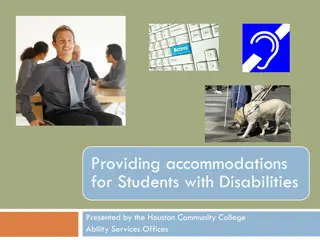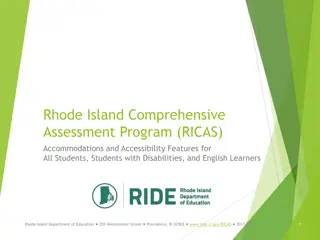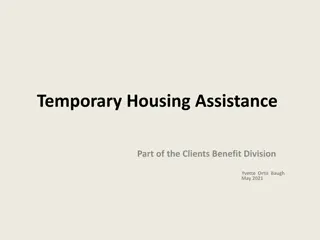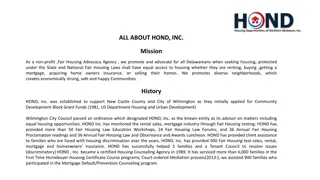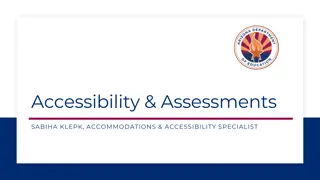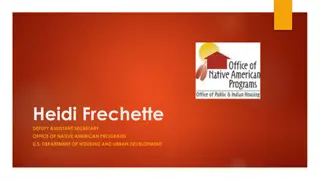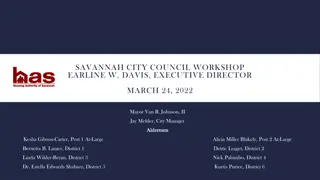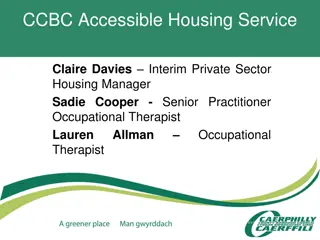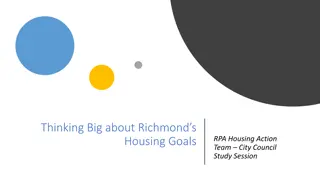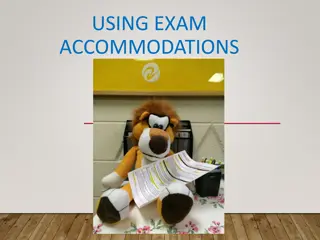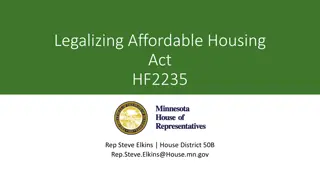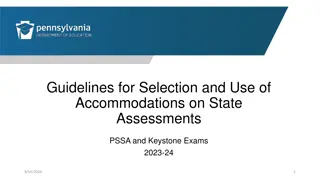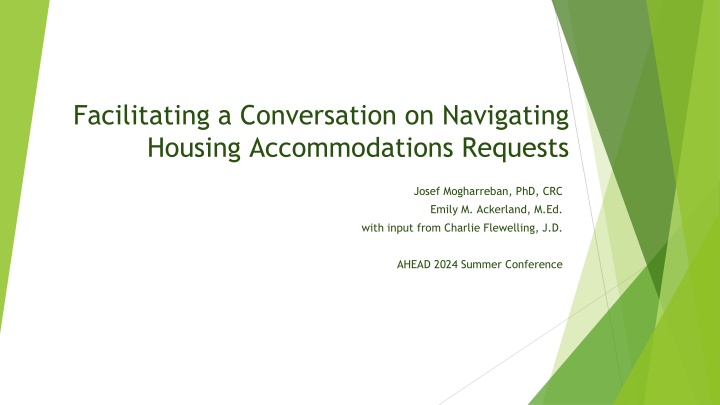
Navigating Inclusive Housing Policies in Higher Education
Discover the significance of inclusive housing policies in higher education, including current trends, legal implications, and federal guidelines. Learn about the impact of COVID-19, the complexity of accommodation requests, budget considerations, and long-term planning for disabilities. Explore how inclusivity and diversity enhance learning environments, promote well-being and safety, and attract and retain students.
Download Presentation

Please find below an Image/Link to download the presentation.
The content on the website is provided AS IS for your information and personal use only. It may not be sold, licensed, or shared on other websites without obtaining consent from the author. If you encounter any issues during the download, it is possible that the publisher has removed the file from their server.
You are allowed to download the files provided on this website for personal or commercial use, subject to the condition that they are used lawfully. All files are the property of their respective owners.
The content on the website is provided AS IS for your information and personal use only. It may not be sold, licensed, or shared on other websites without obtaining consent from the author.
E N D
Presentation Transcript
Facilitating a Conversation on Navigating Housing Accommodations Requests Josef Mogharreban, PhD, CRC Emily M. Ackerland, M.Ed. with input from Charlie Flewelling, J.D. AHEAD 2024 Summer Conference
The significance of inclusive housing policies in higher education (1) Current trends upward COVID-19 impacts Complexity and number of requests required standardization of process Budget impacts Retention Housing crisis
The significance of inclusive housing policies in higher education (2) Inclusivity and Diversity Legal Compliance Equal Opportunity for Education Improved Learning Environment Enhanced Well-being and Safety
The significance of inclusive housing policies in higher education (3) Long-term Planning for Disabilities Attracting and Retaining Students Fostering Independence and Empowerment Positive Reputation and Public Image
Federal Guidelines Three (3) laws we follow 1)Americans with Disabilities Act as Amended (2008) 2)Rehabilitation Act of 1973 (especially section 504) 3)Fair Housing Act (Civil Rights Act of 1968)
Americans with Disabilities Act (ADAAA)/ 504 and its implications for housing Prohibit discrimination against individuals with disabilities. According to these laws, no otherwise qualified person with a disability shall, solely by reason of his or her disability, be excluded from the participation in, be denied the benefits of, or be subjected to discrimination under any program or activity of a public entity.
Fair Housing Act (FHA) and its role in ensuring accessible housing 42 U.S.C. 3601 et seq. Prohibits discrimination in housing-related transactions, including the sale, rental, or financing of dwellings*. Race, Color, Religion, Sex, Familial status (includes families with minor children; pregnant women), National origin, Disability o Discrimination includes refusing to rent to someone, steering someone away to a particular type of housing or neighborhood, enacting zoning measures to exclude particular groups because of membership in a protected class The FHA covers most housing, including federally subsidized and private housing, with few specific exceptions. *Examples of dwellings: houses, apartments, university student housing, farmworker housing, nursing homes, homeless shelters
Documentation under ADA Documentation requirements needed to be reasonable Protections should be broadly construed The question of whether an individual's impairment is a disability under the ADA should not demand extensive analysis"a ADAAA regulations include rules of construction which clarify how and why scientific, medical or statistical evidence will generally not be necessary. They also reflect Congress s support of the idea that disability determination should not be an onerous burden for those seeking accommodations or modifications. Axlerod et al. (2021).
Documentation under HUD/FHA Is more specific about documentation This is geared towards landlords and agencies that are not also doing lots of ADA accommodations Documentation should not be required when disability and need for accommodation is obvious. Documentation MAY be requested when the need is non-obvious There is no MUST regarding documentation under FHA Does not carry the same rules of construction as the ADA Congress never came in and said that people are being categorically denied due to lack of documentation
Documentation and Case Law Piotrowski v. Signature Collision Centers Employee brought in a note about being immunosuppressed and needing to be off for several weeks as covid lockdown started. HR said the note didn t mention reasonable accommodations Employee got a note about work from home as a reasonable accommodation. HR said the note did not say that employee must quarantine. Employee asked exactly what he needed to say in a note 6 days later was fired for not showing up to work or submitting a dr. note.
Interference (Title IV, ADA) Mr. Piotrowski has alleged conduct that meets that definition (of interference). He claims that each time he gave Signature a doctor's note, Signature moved the goalposts and asked for more information. Signature did that even though the ADA does not require any magic words to invoke its rights. Taken in the light most favorable to Mr. Piotrowski, Signature's conduct constitutes meddling in or hampering his ability to invoke his rights under the ADA. Reinforces the idea that under ADA we should not be too stringent in documentation requirements
Our approach Bring cases to counselor meeting (held 2x/wk) where a student cannot get documentation, even in housing. DSOs may still deny for lack of documentation if we don t understand the connection between a request and the disability-related barrier. No housing law(s) conflicts with our process. Providing housing accommodation without tertiary documentation is something we can do; Practice is limited in nature and gets scrutiny from counselors as a group.
Common Types of Campus Housing Traditional Residence Halls Suite-Style Housing Apartment-Style Housing Single-Occupancy Rooms Family Housing Theme or Special-Interest Housing Graduate or Family Housing Complexes Fraternity and Sorority Housing Features: Shared or private bedrooms, communal living spaces, and often include amenities specific to the organization.
Common Accommodations Accessible Housing Emotional Support Animals (ESAs) Priority Placement Adjustments to Physical Environment Technology and Equipment Accessible Common Areas Signage and Communication Flexible Policies Proximity to Services Alternative Housing Options
Communicating with University Residences (UR) We currently do not have AIM (the DAC administrative software) communicating with StarRez (a common UR administrative software), though we believe the capacity exists Both departments keep records in AIM or in StarRez, and communicate them to each other via spreadsheet. Spreadsheet tracks accommodations by quarter, new sheet for every new year. UR and DAC meet regularly to discuss issues and troubleshoot them. Occasionally director-level participants make bigger programmatic decisions. It can be useful in those meetings to have the UR and DAC representatives who regularly collaborate there to answer the fine detail questions. UR will be involved in (at least) the implementation of accommodations, though necessarily in the decision-making process around these accommodations
Service Animals and Emotional Support Animals A brief overview
ESA or SA: Which One Is it? Service Animal Emotional Support Animal Animals that provide emotional support to an individual, such as for depression, anxiety, and certain phobias, but do not have special training to perform tasks that assist people with disabilities. They are not considered service animals under the law. ESA s are also referred to as comfort or therapy animals. According to RCW 49.60.040 "Service animal" means any dog or miniature horse, as discussed in RCW 49.60.214, that is individually trained to do work or perform tasks for the benefit of an individual with a disability: Physical Sensory Psychiatric Intellectual or other mental disability The work or tasks performed by the service animal must be directly related to the individual's disability From https://crtc.wwu.edu/compliance/ADA/animals
ESA or SA: How Should DSOs Proceed? Service Animal Emotional Support Animal Require students to engage in the interactive accommodations process May request but not require students to engage in interactive process The relationship between the disability-related barrier and requested accommodation should be clear However, may establish priority deadlines to live with an animal in University Residences May ask two questions: May request third-party supporting documentation; primary and secondary documentation may also be useful Is the animal a service animal required because of a disability? What work or task has the animal been trained to perform? Tip: Work with UR to discuss how ESAs and SAs will work in the context of emergency housing
Partnerships: Campus Stakeholders How did we get here? Re-shaping the lens from fair to equitable Re-shaping the lens from a cost-benefit analysis to one of equity and compliance Re-shaping the conversation around capacity to one of task- sharing, cost-sharing, training, and partnership Re-shaping and standardizing communication across departments to all stakeholders
Case study: Partnerships in action Internal partnerships Dining Affinity Programs University Residences dedicated DAC liaison Facilities CRTC (Civil Rights and Title 9 Compliance) Transportation Basic Needs Resources Behavioral Intervention Team (BIT)
University Residences/DAC Retreat Helping students navigate the system Proactive collaboration around care and conduct Integrate DAC and UR collaboration throughout the staff Collaborate with Dining Educate neurotypical students and the University Residences community about neurodiversity Engage in transparency around expectations and processes Come to common understanding of "reasonable"
Overarching purpose Intentionally strengthen connection between departments and generate ideas for greater collaboration, toward the shared goal of fostering success for students in need of housing accommodations.
Intentional Representation Director and Assistant Director of DAC DAC Access Managers Director, University Residences Associate Director, UR Occupancy Associate Director, UR Facilities Assistant Director, Residence Life Food Service Director, Aramark AVP, Student Access, Community, and Intercultural Engagement Discussion of other essential stakeholders not at the table Advising, New Student Outreach Coordinator, Admissions, University Technologist, Parking
Shared vocabulary Foundational How is reasonable accommodation defined and conceptualized? Accommodation process Housing process 30+ individualized and common accommodations Mitigate guesswork Reduce confusion Ex.
Streamlining communication From one to many And in the future, hopefully many more Dedicated Microsoft Teams group with DAC pro staff, University Residences liaison, dining, office of student life, etc. Privacy, confidentiality Website collaboration Establishing weekly meetings between DAC and UR Integration/training of all staff, not just Directors Primary points of contact Leveraging existing technologies in new ways It is bulky with three record-keeping spaces (plus email), but through our diligence, a recent audit found no missing accommodations.
Action Items, next steps Student-facing workshops How to apply for housing accommodations, view assignments, what to do if there's a problem, etc. Coordination of UR accessibility tours Intracampus transportation Chatbot? Texting Calendaring



